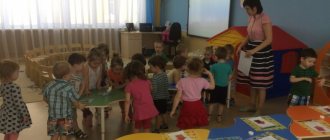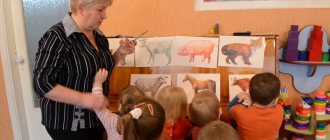Summary of educational activities for speech development in the middle group on the topic “Pets and birds”
Summary of educational activities for speech development in the middle group on the topic “Pets and birds”
Author of the development
: Barinova V.P.,
Educational field:
cognitive development, speech development
Age:
children 4-5 years of age
Goal:
1. Enrich and systematize vocabulary .
2. Activate and consolidate speech on the topic “Pets and poultry” 3. Develop attention, thinking, memory, visual perception. Objectives:
1. Consolidate the general concept of “domestic animals and poultry”.
2. Development of children's speech activity. 3. Development of articulatory motor skills. 5. Development of general motor skills. Equipment:
Mail bag, toy house, model of a home yard, cardboard figures of baby birds and animals: duckling, chicken, puppy, foal, calf, kitten, cut and whole pictures depicting domestic animals and birds for each child, phonogram “Dance of the Little Ones” ducklings"
Lexical material: Words - objects:
invitation, cat, kitten, dog, puppy, cow, calf, horse, foal, duck, drake, duckling, rooster, hen, chick, birds, animals Words -
signs:
pets, pets birds.
Words - actions:
meow, bark, moo, neigh, quack, crow.
Progress of the lesson I. Organizational moment
Let's gather the children in a circle - I am your friend and you are my friend. Let's hold hands tightly and smile at each other.
Educator:
Guys, are you in a good mood?
(Children's answers) II. Main part Educator
: Friends, this mail bag and letter were brought to our group early in the morning.
Let's read it? (Yes) “Hello, guys! The postman Pechkin is writing to you. The fact is that I am sick and cannot deliver mail, so I ask you to help me. In my bag there are invitations to the birthday of a wonderful baby who is looking forward to guests for his holiday. And you will find out who this birthday boy is by guessing the riddle: Amazing child! Just out of diapers, he can swim and dive, like his own mother. (Duckling) Educator:
Well done, of course, it’s a duckling.
Well, guys, let’s help Pechkin and send out invitations? (Yes). So, the first invitation. Who should receive it? A yellow dandelion walks through the yard, A yellow dandelion pecks at the grains. (Chicken) Educator:
That's right, chicken, where do you think you should look for a chicken in the forest or on a home farm?
(On a farm, because it is a poultry) Children approach the chicken figurine and hand over an invitation letter and return to the teacher. Guys, show with your fingers how the chicken pecks the grains (with the fingers of one hand on the palm of the other). Well done! Educator:
Who is the second invitation addressed to?
The cow gives milk. Children with him are always healthy. The cow has a child - Nice, little... (Calf) Educator:
(Domestic) Children go and give a letter to the calf
Educator:
Tell me, is the calf a domestic animal or a wild one?
(Homemade). Children approach the calf figurine, hand over a letter of invitation and return to the teacher. Guys, let’s show how a calf butts with its horns” (put your index fingers near your head and shake it) You’re doing great. Educator:
But the third invitation awaits the Living Castle, He lay down across the door.
(Puppy) Educator:
Tell me, where will we look for the puppy?
(in the home yard, because the puppy is a pet) The children give the invitation letter to the puppy and return to the teacher. Guys, let's show how a puppy runs after its tail (run around itself) Isn't it fun? The fourth invitation, guess who is waiting? Mom is a horse, dad is a horse, Who is their child? Red, like fire, This is a foal. Educator:
Tell me, is a foal a domestic animal or a wild one?
(Home) Children approach the foal figurine, hand over a letter of invitation and return to the teacher. Guys, let’s show how a colt gallops” (jumps in place and flicks his tongue) What a great fellow you are. Educator:
Well, we will give the fifth invitation to the beast that plays with me: Doesn’t moo, doesn’t neigh, doesn’t bark, Attacks balls, Hides claws in its paws!
(Kitten) Educator:
Tell me, is a kitten a domestic animal or a wild one?
(Home) Children approach the kitten figurine, hand over an invitation letter and return to the teacher. Guys, how does a kitten drink milk” (the tongue is sometimes shown, then hidden) Educator:
Well done, guys, we handed out all the invitations that the duckling sent, but little children don’t go to visit on their own.
Who should they go with? (With mom (parents), etc.) Educator
: That's right, now let's sit down in our seats, there are cut pictures, when you put them together, you will see who our kids will go with.
Children:
sit at the tables and put the pictures together.
Teacher:
At the end of the work, asks everyone who is shown in the picture and whose mom or dad it is.
When he receives an answer, he puts a whole picture of the parent next to the cub’s figurine. Educator
: Guys, you are so great.
Now we will all go together to visit the duckling. (Each child takes a picture of a pet or its baby). Look, there is a house there, our birthday boy probably lives in it. The teacher and children approach the house, behind which figures of a duck and a duckling are displayed. Educator:
Guys, let's say hello.
(Children say hello). (Afterwards, those who have a picture of the named animals in their hands imitate their greeting) And now the drake, duck and duckling (quack-quack), and now the cow and calf (moo-moo), chicken (pee-pee-pee), chicken (ko-ko-ko), rooster (ku-ka-re-ku), foal and horse (i-go-go), cat, cat and kitten (meow-meow). Educator:
And now the duckling invites us to a fun dance.
Everyone is dancing to the tune “Dance of the Little Ducklings.” Educator:
Guys, we had fun at the duckling’s party.
Did you like it? (Children's answers) It's time for us to say goodbye, let's thank the duckling for the invitation and say goodbye. The children leave the house and sit down at the tables. III. Summary of the lesson Educator:
Guys, what do you think, did the duckling have a holiday?
(But why? (Children's answers) And if we had not sent out the invitations, would the holiday have taken place? What did you remember and like most? (Children's answers) Educator:
Let's remember which pets we gave the invitation to (Horse, cat, cow, dog, etc.) And which pet birds?
(duck, drake, chicken, rooster, etc.) Why are animals and birds called domestic? Children:
They live next to people. People care about them. And they bring benefits to people.



